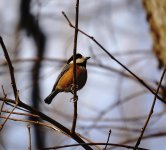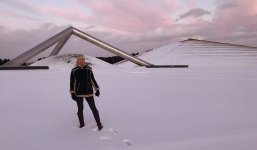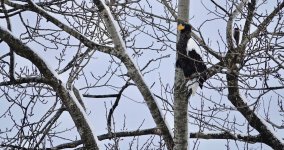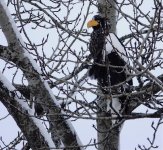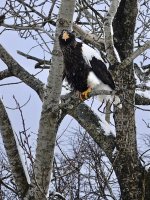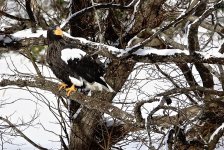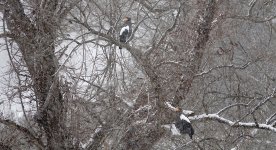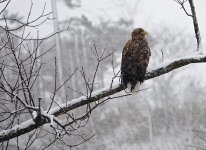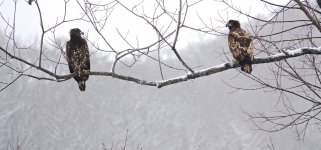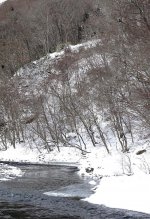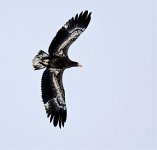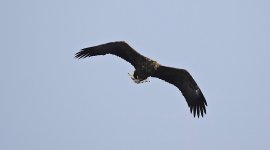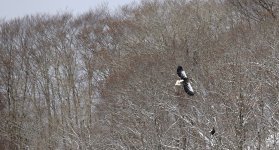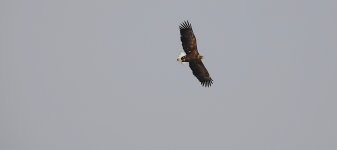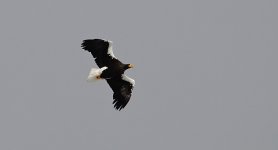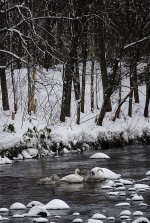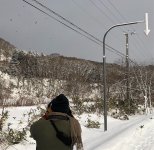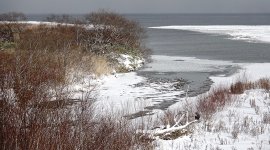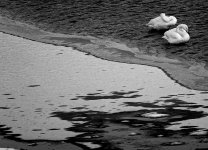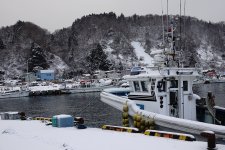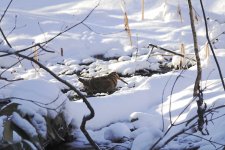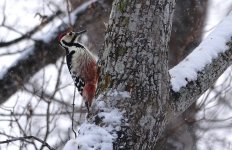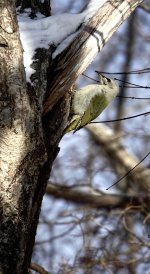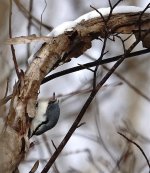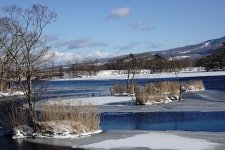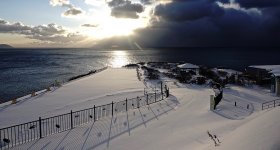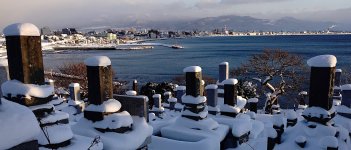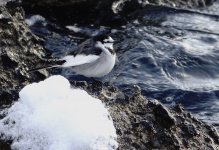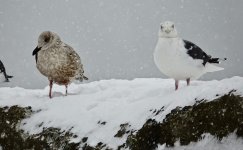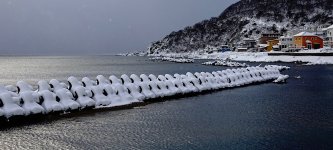MKinHK
Mike Kilburn

My wife Carrie and I flew from Hong Kong to Sapporo via Nagoya on Hong Kong Express and Japan Airlines on Christmas Eve, arriving in Sapporo after dark. The only birds I saw that day were five unidentified ducks rocketing past the aircraft at alarmingly close range just as we landed at Nagoya.
A lazy Christmas Day, which included a visit to the beautifully snow-covered Moerenuma Park – a giant landscape-sculpture garden - delivered a grand total of five species. The most abundant were Large-billed Crows, seen both from the hotel (which sits right next to Hokkaido University Botanic Garden), and at least a couple of hundred flying over the park and back into the city to roost as dusk fell. Other birds included four Brown-eared Bulbuls - a rather elongated dark-brown and grey bulbul with a scraggly head feathers, a long tail and a fine range of whiny calls, a solitary Feral Pigeon, a large unidentified raptor among the crows and a hardy Little Grebe on the still-flowing canal along the southwestern corner of Moerenuma Park.
Boxing Day started more promisingly with a walk around the beautifully sunlit Botanic Garden. That was literally “around” as it is closed between December and March and I was reduced to peering through the fence. I started with the Hokkaido endemic subspecies of Red Squirrel – chocolate brown with a white belly and delightful ear tufts – foraging decoratively along snow-covered branches. As I watched it I started to hear birds, picking up a couple of Brown-eared Bulbuls and then three fabulous white-headed caudatus race Long-tailed Tits. These were the first of a mini-wave including a couple of Marsh Tits, four or five Japanese Tits and three handsome chestnut-bellied Varied Tits. Thirty-odd Oriental Greenfinches flew into the park from some trees just to the north, and the list was completed by a Great Spotted Woodpecker, and a dozen Tree Sparrows feeding on something that looked very like yew berries.
The railway journey to from Sapporo to Onuma - to get ourselves in position to go for Steller's Sea Eagles the next day - delivered a pretty good selection of species. The top birds were 11 White-tailed Eagles, most of which were adults, spread over four river mouths, where apparently they gather to scavenge on whatever edible goodies drift downstream. They eagles were almost always attended by a retinue of Black Kites. I also had a flock of over 100 Black Kites above what presumably was a landfill. The other quality birds were four Goosanders, thirty or so Whooper Swans, and a dozen or so Temminck’s Cormorants along the rockier parts of the coast, and thirty-odd Mallards in two different flocks. The only gulls I was able to identify were Slaty-backed Gulls, while a distant flock of 25-odd geese went unidentified. The only other sighting was the large gathering at dusk of several hundred Large-billed Crows on the wires either side of Mori station.
Cheers
Mike
A lazy Christmas Day, which included a visit to the beautifully snow-covered Moerenuma Park – a giant landscape-sculpture garden - delivered a grand total of five species. The most abundant were Large-billed Crows, seen both from the hotel (which sits right next to Hokkaido University Botanic Garden), and at least a couple of hundred flying over the park and back into the city to roost as dusk fell. Other birds included four Brown-eared Bulbuls - a rather elongated dark-brown and grey bulbul with a scraggly head feathers, a long tail and a fine range of whiny calls, a solitary Feral Pigeon, a large unidentified raptor among the crows and a hardy Little Grebe on the still-flowing canal along the southwestern corner of Moerenuma Park.
Boxing Day started more promisingly with a walk around the beautifully sunlit Botanic Garden. That was literally “around” as it is closed between December and March and I was reduced to peering through the fence. I started with the Hokkaido endemic subspecies of Red Squirrel – chocolate brown with a white belly and delightful ear tufts – foraging decoratively along snow-covered branches. As I watched it I started to hear birds, picking up a couple of Brown-eared Bulbuls and then three fabulous white-headed caudatus race Long-tailed Tits. These were the first of a mini-wave including a couple of Marsh Tits, four or five Japanese Tits and three handsome chestnut-bellied Varied Tits. Thirty-odd Oriental Greenfinches flew into the park from some trees just to the north, and the list was completed by a Great Spotted Woodpecker, and a dozen Tree Sparrows feeding on something that looked very like yew berries.
The railway journey to from Sapporo to Onuma - to get ourselves in position to go for Steller's Sea Eagles the next day - delivered a pretty good selection of species. The top birds were 11 White-tailed Eagles, most of which were adults, spread over four river mouths, where apparently they gather to scavenge on whatever edible goodies drift downstream. They eagles were almost always attended by a retinue of Black Kites. I also had a flock of over 100 Black Kites above what presumably was a landfill. The other quality birds were four Goosanders, thirty or so Whooper Swans, and a dozen or so Temminck’s Cormorants along the rockier parts of the coast, and thirty-odd Mallards in two different flocks. The only gulls I was able to identify were Slaty-backed Gulls, while a distant flock of 25-odd geese went unidentified. The only other sighting was the large gathering at dusk of several hundred Large-billed Crows on the wires either side of Mori station.
Cheers
Mike
Attachments
Last edited:




